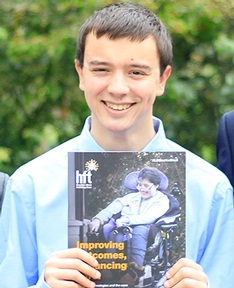The care group Hft is urging the government to unleash the untapped potential of assistive technologies by creating a ‘sector deal’ to help those with learning disabilities.
William, who has autism, helped launch the report by describing the benefit assistive technologies had on his life. Credit: Hft
The new report launched by the national learning disabilities charity Hft, which runs care homes and home care services, said the government should create a sector deal for the learning disability sector to harness the ‘untapped economic potential’ from a growing market in assistive technologies.
The UK government’s Industrial Strategy first promoted the concept of a ‘sector deal’ involving partnerships between the government and industry to boost innovation and skills.

'The sector have to look to each other to find solutions'
“Delays to the government’s social care green paper has meant that we in the sector have had to look to each other to find solutions to the issues we face” said Robert Longley-Cook, chief executive of Hft, which supports 2,900 people with learning disabilities.
A learning disability can be mild, moderate, severe or profound and is defined as having a reduced ability to understand new or complex information, learn new skills and live independently.
Learning disabilities account for approximately 35 per cent of adult social care spend in England.
The chief executive added: “As it stands, the learning disability sector accounts for around a third of adult social care spend in England and demand is growing rapidly as life expectancy increases.
“By granting a Sector Deal to the learning disability sector, the government can help to stimulate investment and innovation, bring financial stability to providers within the sector, and ultimately deliver the outstanding person-centred support that adults with learning disabilities deserve.”
Assistive technologies can manage risks in the home, such as fires or falling, aid communication, deliver greater privacy and can also connect people with their community, with mobile devices which help them travel to work and undertake leisure activities. The telecare market was worth £252m in 2015.
The report called ‘Improving outcomes, enhancing care: assistive technologies and the case for a sector deal for the learning disability sector’ called on the Department for Health & Social Care to launch an inquiry into how assistive technologies can be used to upskill low-paid staff in the social care sector, and explore ways in which this can help raise the wage levels of upskilled staff.
William: 'I feel safe'
Hft argues a sector deal would help more people like 22-year-old William who has autism. He shared his personal experience of how technology helped him achieve his dream of living independently in the community.
“I feel safe and secure knowing I am only one button away from calling anyone at any time” said William.
William uses a key fob to enter his home, which can be deactivated and replaced if lost, and has a lifeline phone and pendant alarm to use to call for help in the event of an emergency.
Anna has epilepsy and was supported by Hft to go on holiday in Devon thanks to a Personalised Technology (PT) team’s holiday kit.
The holiday kit came with a staff pager, a door sensor and a bed occupancy sensor.
The pager was linked to the bed occupancy sensor which was programmed to alert care staff supporting Anna on her trip if she got up in the night and didn’t return to bed after two minutes.
The door sensor alerted care staff if Anna opened her bedroom door. Anna's epilepsy sensor was programmed into the pager and could detect repetitive movement and raise an alert on the staff pager if she has a seizure at night.
The document was published by Hft in collaboration with Tunstall Healthcare, which works with care organisations around the world.
Hft is a member of disability charity Voluntary Organisations Disability Group (VODG). Dr Rhidian Hughes, chief executive of VODG said: “Hft have produced a timely report which shines an important spotlight on the untapped potential of assistive technology.”